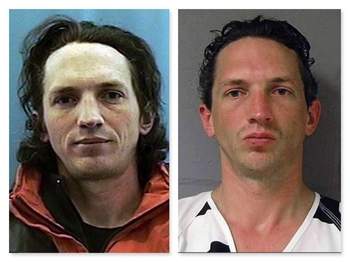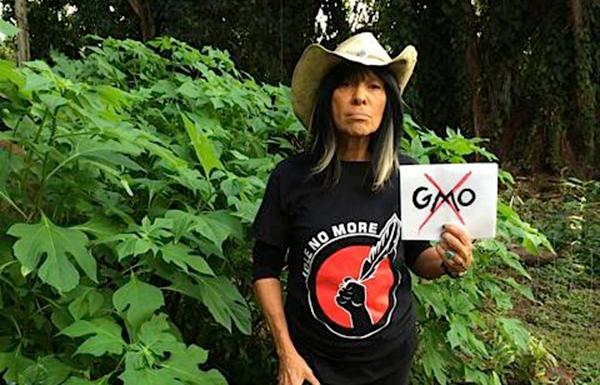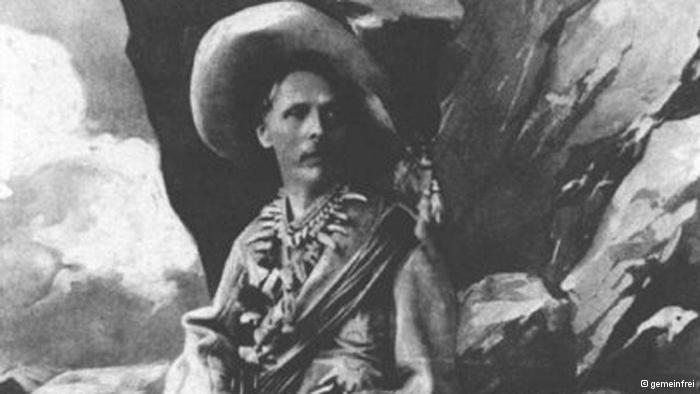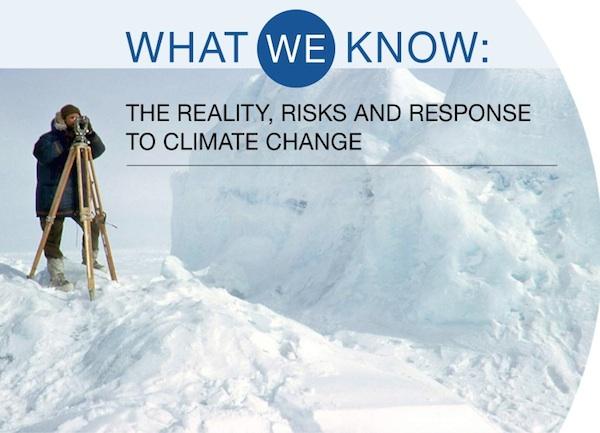Author: Kim Kalliber
Collection of Native American paintings for sale
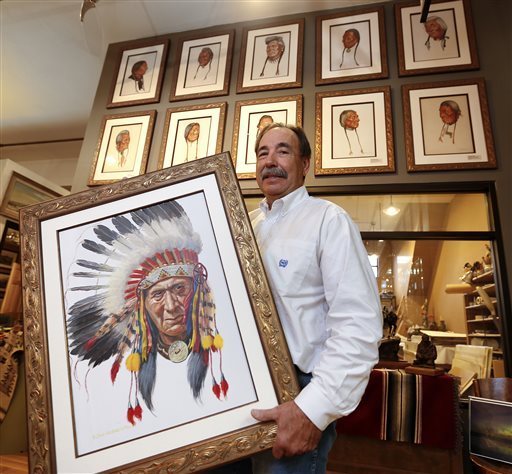
LARRY BECKNER — AP
By JAKE SORICH, Great Falls Tribune
GREAT FALLS, Mont. — A collection of paintings, photos and sketches depicting some of the last pre-reservation Native Americans, including survivors of the Battle of the Little Bighorn, could sell for more this weekend than any of the other individual works during Western Art Week.
The Wrangler Gallery, located at 316 Central Ave., is seeking a buyer for the 122-piece David Humphreys Miller collection. Gallery owner Brad Hamlett says it is worth $3.8 million, according to an independent appraiser who looked at it recently.
It’s on display at the gallery throughout Western Art Week. The collection is owned by a family friend of the Millers who’s a representative with the Solomon Family Trust.
“This collection belongs in a museum where the public can access it and study it,” Hamlett said. “It’s also a very interactive exhibit. Native people come in to see it, and they may see members of their family who never had a photo taken of them, but they will remember them and start talking about their memories.”
Included in the collection are more than 50 sketches of the survivors from the Battle of the Little Big Horn and exclusive photos from the various Hollywood westerns Miller worked on with the Sioux Natives he brought to appear in the films. He would then collect the money given to the Natives and make sure they were given their fair shares once they returned to the reservation.
Some of the films Miller worked on as adviser include “Cheyenne Autumn” and “How the West was Won.” He worked on 25 films in total, bringing authentic Natives to play Indians in the films.
Miller, of Ohio, was 16 when he came to Montana and the Dakotas in 1935 to interview the surviving warriors who had wiped out the U.S. Army forces led by Gen. George Armstrong Custer in 1876.
He formed a lifelong relationship with the people. Over the course of his life, Miller learned 14 Indian languages, including sign languages, and was adopted into 16 different Indian families.
He also wrote two books about the battles titled “Custer’s Fall: The Indian Side of the Story” and “Ghost Dance.” Both books are on display in the exhibit.
In his artist’s statement, Miller wrote that he began his journey with the goal of finding out what happened from those who survived the battles. He said it was a long task that took many years to complete.
“I recall feeling a considerable sense of urgency when I began my quest. Will Durant has written that ‘no man in a hurry is quite civilized,'” he writes. “I was anything but civilized in my haste to find as many old Indian veterans of Little Big Horn as I could to straighten out history. The Indians almost certainly had never even heard of Durant, yet I found there was no way of hurrying them. The project of seeking them out, persuading them to pose for their portraits and interviewing them about their individual roles in the Custer Fight took a number of years —1935 through 1941 and 1946 through 1955 when the last survivor died.”
In 1972, Miller’s works won the Western Heritage Award from the National Cowboy Hall of Fame. Beyond the artwork, many of the old black-and-white photos in the collection are one-of-a-kind images.
Hamlett said they’ve recently had the curator from the Museum of the Rockies in Bozeman at the gallery looking at the collection. He said the curator told him that just the photographs and negatives were worth $600,000.
Hamlett said the collection also includes several priceless artifacts, including the headdress of John Sitting Bull, the Northern Apache ghost dancer and stepson to the Sioux Chief Sitting Bull.
There also is a rare Ghost Dance Shield, given to Miller as a wedding gift July 4, 1954, by Sam Helper, who survived the Ghost Dance massacre, also known as the Wounded Knee massacre, in December 1890.
All of the artifacts were given to Miller as gifts and cannot be sold, Hamlett said, but will be given to a museum that might look to show the collection.
Some of the more interesting pieces featured in the 95 sketches and 25 oil paintings include:
. Black Elk, subject of the book “Black Elk Speaks,” the Sioux warrior who adopted Miller as his son;
. Chewing Black Bones, the Blackfeet warrior for whom the campground near St. Mary is named;
. Juniper Old Person, father of Earl Old Person, chief of the Blackfeet Nation; and Joseph White Bull, who told Miller that he killed Custer in hand-to-hand combat. The body was identified after the battle by an Indian woman who had been captured by Custer and bore him a son, White Bull told Miller.
Many of the portraits painted by Miller between 1935 and 1941 are of the 70 surviving Indian warriors from the Battle of the Little Bighorn quoted in “Custer’s Fall.”
A portion of the collection was shown at the University of Wyoming in 2012.
Barbara Koostra, director of the Montana Museum of Art and Culture at the University of Montana, said the museum would be interested in acquiring the exhibit but does not have the financial resources to buy it.
“A few years ago our museum made inquiries about this collection in terms of a potential gift. This is due to the fact we have no acquisition funding,” she said. “At that time, there was not a desire to gift the collection and it appears their desire to sell continues. We’d be extremely interested in such a collection coming to our public collection but are not in a financial position to acquire it in terms of a purchase.”
Similarly, the Montana Historical Society has viewed the exhibit but does not have the resources to purchase it, either.
“It’s appears to be a wonderful and important collection but not something that is on our priority list at this time,” Historical Society Director Bruce Whittenberg said.
The owner of the collection, who wished not to be identified, said Miller never sold any of his artwork. She said he saw it as a chance to tell the story of the Native people who survived these historically important battles by hearing it directly from them.
“He had a wonderful life and did what he wanted to do,” she said.
Hamlett said the gallery owner inherited the collection after the Millers died and wishes to sell it to help share Miller’s memory, and the historical importance of his paintings, with the world.
“She was one of (the Millers’) best friends and she had gone to the reservation with them from time to time and she knew how important their personal relationships with the native people were,” Hamlett said. “In fact, Miller actually was buried on the Sioux reservation.”
The Millers especially became close friends with Dewey Beard and his family. Beard was the last living survivor of the Battle of the Little Big Horn and the Battle of Wounded Knee. He lost his first wife, his parents and children in the battles.
The collection’s owner said Miller was accepted as a member of the family among people in the tribes he visited such as Beard and others.
Some other interesting aspects of Miller’s life include his work as host of the 1950s TV show “Cavalcade of Books,” in which he interviewed authors and speakers. It was on his show that he interviewed Richard Nixon. He also did portraits of famous Hollywood icons such as Charlton Heston and Milburn Stone.
Miller’s wife, Jan, worked as a researcher on the program “This Is Your Life.” Before meeting Miller, she was a reporter for a daily newspaper in New Orleans. She first met Miller when she interviewed him for a story. They met again a few years later and married shortly thereafter.
More than anything, however, Hamlett said Miller’s curiosity in the Northern Plains culture was by far the most enduring aspect of his life.
“I think he had a sincere interest in history and he wanted to find out what happened, and the only ones who could tell him were the Indians,” Hamlett said. “There’s no other collections like this one, historically or artistically, especially because he used the oral history of these people that would be gone if he hadn’t come along and wrote it down and showed these people through his art.”
Information from: Great Falls Tribune, http://www.greatfallstribune.com
TV show to profile late Alaska serial killer
By RACHEL D’ORO, Associated Press
ANCHORAGE, Alaska — An upcoming special episode of Investigation Discovery’s “Dark Minds” TV series says it has new information about confessed Alaska serial killer Israel Keyes, including the identity of a potential victim.
Keyes was believed to have killed at least 11 people before committing suicide in his Anchorage jail cell 15 months ago while awaiting a federal trial in the rape and strangulation murder of his last known victim, Samantha Koenig. The 18-year-old Anchorage woman was abducted in February 2012 from the local coffee stand where she worked.
The two-hour, season-opening “Dark Minds” episode scheduled to air April 2 reports what it says are new details about the Koenig case. The episode, which includes dramatizations by actors, also suggests a man who disappeared from Washington’s Olympia National Park in 2004 — Gilbert Gilman — was an undisclosed victim of Keyes, who had been in the region to participate in a marathon. And it claims Keyes identified himself as a bisexual and a necrophiliac.
Series creator and host M. William Phelps told The Associated Press that he spent more than a year investigating Keyes, interviewing people including authorities, a serial killer he calls “Raven,” a criminal profiler, people who knew Keyes, as well as former Assistant U.S. Attorney Craig Warner, who was present during many of Keyes’ interviews with the FBI.
“It really exhausted me, emotionally and physically, this case,” Phelps said Wednesday. “I was just living it 24/7.”
After the Koenig kidnapping, Keyes reportedly sipped wine in a toolshed outside his home, telling his victim there exactly what he planned to do before he sexually assaulted and killed her, leaving her body in the shed before embarking on a cruise the next day. The series also claims Keyes later sewed open the eyes of the dead and frozen victim to make her look alive as he photographed her with a new copy of a local newspaper.
Authorities have already revealed that Keyes wrote a ransom note on the back of the photo, demanding that $30,000 be placed in Koenig’s account. He texted a message, directing the family to a dog park where the note could be found. Her family deposited money from a reward fund.
Keyes also said he robbed banks to help pay for his travels to find random victims.
Keyes, the second eldest in a large family, was homeschooled in a cabin without electricity near Colville, Wash., in a mountainous, sparsely populated area. The family moved in the 1990s to Smyrna, Maine, where they were involved in the maple syrup business, according to a neighbor who remembered Keyes as a nice, courteous young man.
After leaving the Army, Keyes worked for the Makah Indian tribe in Washington, then moved to Anchorage in 2007 after his girlfriend found work here. A self-employed carpenter and handyman, he was considered competent, honest and efficient. He had a young daughter who lived with him and his girlfriend in Anchorage.
Keyes was arrested in Lufkin, Texas, about six weeks later after using Koenig’s debit card. Three weeks after the arrest, Koenig’s dismembered body was found in a frozen lake north of Anchorage.
The FBI and other authorities have been able to link Keyes to the only three victims he named — Koenig and an Essex, Vt., couple, Bill and Lorraine Currier, who disappeared in 2011. In months of interviews with authorities after his arrest last year, Keyes toyed with investigators, doling out snippets and clues about other possible victims across the country as he demanded a promise that he would be executed rather than spend his life in prison.
Keyes never disclosed much information about the other crimes, trying to keep as many details as possible out of the media so his daughter wouldn’t be able to find any information up on the Internet or his mother wouldn’t have a heart attack reading what he did.
The FBI has publicly released a timeline of travels and crimes by Keyes, hoping to shed light on unsolved killings in the nation. Authorities have been trying to determine whether Keyes was involved in the 2009 disappearance of a New Jersey woman, Debra Feldman, who was last seen at her Hackensack home.
Anchorage-based Special Agent Kevin Donovan with the FBI said Wednesday he didn’t immediately know the status of the New Jersey case. He also said authorities have received information about cases that could be tied to Keyes and are following up on it. But he said he wouldn’t characterize any of it as strong leads.
“We are still looking for any additional information from the public or from law enforcement that might help us identify additional victims,” he said.
At the end of the upcoming episode, Phelps urges viewers to help solve mysteries that remain about Keyes and his unknown victims.
“I hope the families can have some answers from this,” he said. “That’s my goal.”
New Emergency Room Guidelines Help Washington Save Millions, Cut ER Visits

Credit UMHealthSystem / Flickr
Washington’s Medicaid program saved more than $33 million last year, and a new report gives much of the credit to a big push to reduce emergency room visits.
ERs are a great place to treat real emergencies, but a very expensive place to do run-of-the-mill medical care. So the Health Care Authority, the agency that runs Medicaid, partnered with the Washington State Hospital Association, the Washington State Medical Association and others to adopt seven best practices aimed at ensuring ERs are used for their intended purpose.
They include things like keeping tabs on frequent ER users, referring people to primary care doctors and tightening up policies around prescribing narcotics.
The HCA’s chief medical officer Daniel Lessler says one crucial practice is sharing patient information among ERs, which can reduce costly duplications.
“A patient who is seen in an emergency room for a headache and got a head CT comes in with the same complaint to another emergency room three days later. Without that information, they probably are going to repeat the work-up,” Lessler said.
In fiscal year 2013, ER visits dropped by 10 percent. Visits by those frequent users dropped even more, as did the rate of visits resulting in a scheduled drug prescription.
The ER reforms probably aren’t the only reason for those changes and the cost savings. Lessler says other changes over the same period, like moving people to managed care, probably get some credit.
A large study in Oregon recently found that expanding Medicaid to more people increased ER use, rather than decreasing it as hoped. That finding is controversial, but Lessler notes that Washington’s ER reforms put it in a good position as the state adds hundreds of thousands to the Medicaid rolls as a result of the Affordable Care Act.
The HCA and its partners plan to detail the findings at a noon announcement Thursday.
Buffy Sainte-Marie on Tar Sands: ‘You’ve Got to Take This Seriously’
For decades, Buffy Sainte-Marie has been an artistic trailblazer. The Sixties folk explosion saw the Canadian-born Cree songwriter confront the colonial status quo with hit songs like “Bury My Heart at Wounded Knee” as well as the anti-war anthem “Universal Soldier.” Sainte-Marie, who is currently based in Hawaii, is gearing up to record her first album of new material since 2008 (more on that later), and took a few minutes to share her thoughts on a number of topics with ICTMN.
We’ve seen your Tweets (@BuffySteMarie) about the oil sands, or tar sands as they’re sometimes called — what’s your take on the situation?
Almost a year ago I went to Fort McMurray (Alberta) and I was just devastated with what’s going on there. Just devastated. I just told everybody I could: “You’ve got to take this seriously.” Even since I was there, other people have really stepped forward in their own ways, Neil Young in particular. He’s caught a lot of criticism because he didn’t involve me, Susan Aglukark or other Native people. Neil came to the induction ceremony in Nashville, at the Musicians Hall of Fame, and I told him I’d seen some of the criticism and not to listen to it at all! Because it’s so important, it has to be everybody doing whatever they can, whenever they can, and being effective at whatever level they can be. You reach people your way, I do it my way and Neil does it his way. But people have to see it.
RELATED: Neil Young: Blood of First Nations People Is on Canada’s Hands
It’s really worth a trip to Fort McMurray just to see it with your own eyes. If you really want to see something historic in your life, go to Fort McMurray and just bear witness to what they’re doing. It’s never going to return, and this is the future of the planet if the present people are allowed to stay in charge. We are allowing them to stay in charge. We are allowing it. That’s why we have wars. We have to be really vigilant and supportive of one another, because it has to stop. There’s no turning back.
Neil Young toured with the First Nation that’s experiencing high cancer rates from the tar sands. And yet he also caught criticism when people said, “Oh, he’s just an outsider, he lives in California — what right does he have to criticize this?”
(Laughs). Because it’s not only about Canada, that’s why! Good for Neil for stepping up. Everybody should be stepping up at whatever their most effective level is. It’s not just about Native people and it’s not just about Canada. Just the weather changes are indicative: people just gotta wake up.
Have the issues changed over time, or is it still the same root issues as in your songs “Bury My Heart at Wounded Knee” or “Universal Soldier”?
The root issue is always the same. It’s about corporate greed in charge of all of our energy. That’s the root issue. But in the 1500s it was gold and silver in Central America, and then coal, oil, and now uranium. I have a song that’s going to be on the album I’m recording now called “The Uranium War.” It has a line:
Coal and oil and hey, now uranium
Keep the Indians under your thumb
Pray like hell when your bad times come
Get ’em up, rip ’em up, strip ’em up
Get ’em with a gun.
So the violence that occurs, and has been occurring against Indigenous People in the world because of resources has now become obvious to the non-indigenous people too. There are now more people understanding how devastating the misuse of resources not only can be, but just plain is.
Let’s talk about the Longest Walk. Richie Havens passed on last year, and you were a long supporter of the Longest Walk and affirming treaty rights. Could you offer some thoughts on him, his passing and his legacy?
He and I kind of emerged around the same time — the summer of 1963-4. We would see each other over the years. He came and visited me in Hawaii a few times. We were good friends. He was such an incredible interpreter of other people’s songs, and such a good guy. Pete Seeger too — he just did so much for the world through music, in ways both subtle and big. You know, heaven must be a great place, because there’s a lot of people going there!

You were with Pete Seeger at Clearwater Fest last summer. The photos were just beautiful, you guys having a lovely hug.
He was just really, really special, huh?
Do you ever feel nostalgic for that era, when you all emerged almost at once? It must have been such a different energy because it was also a social movement as well as being about music.
It was, but I’ve been waiting for it to come back. And I think it has. For me, the Internet is like the Sixties. It used to be, in the Sixties, all kinds of music was available to you, but it was kept away. You had to go with this label and that genre. It really became a very narrow-minded corporate world. They’d sign 90 artists and shelve 90 others. It used to be so unfair. But now you can hear all kinds of music, and everybody can get played, publish a song, or share things on the Internet. It’s such a wonderful time that we’re living in. You shouldn’t discount it or think that the Sixties were better. The Sixties were about a true student movement. And now there’s another true populist movement, so let’s do what we can, while we can.
To learn more about Buffy Sainte-Marie, visit her official site BuffySainte-Marie.com.
Read more at http://indiancountrytodaymedianetwork.com/2014/03/19/buffy-sainte-marie-tar-sands-youve-got-take-seriously-154085?page=0%2C1
Trash from the K-Cups sold last year would circle the Earth almost 11 times
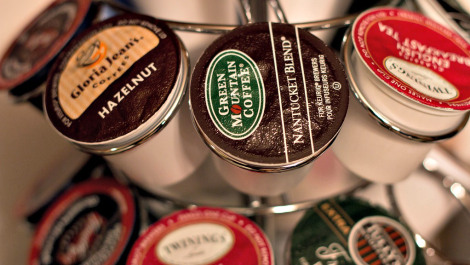
By Holly Richmond, Grist
K-Cups seem like the complicated Starbucks order of today: an expensive, caffeinated way to express your oh-so-unique taste and personality. Who needs to run out for a tall caramel macchiato when you can make a single serving of Wolfgang Puck’s Jamaica Me Crazy medium roast in the comfort of your kitchen?
Except all those little plastic cups add up to some massive trash. Ten and a half loops around the equator, in fact, according to Mother Jones. Kind of ridic for a company owned by a fair-trade, organic coffee brand, no?
Plus, the No. 7 plastic blend is BPA-free, but that doesn’t mean it’s safe. Even if all that plastic magically disappeared into the ether on disposal, its manufacture could be making workers sick, writes MoJo:
One concern with this plastic mix is the presence of polystyrene, containing the chemical styrene, which Hoover warns is especially worrisome for workers. A possible carcinogen, styrene can wreak havoc on the nervous systems of those handling it, according to the Centers for Disease Control and Prevention…
Keurig would not tell me what types of plastic go into its #7 blend, saying the information was proprietary, nor would it confirm or deny the presence of polystyrene in the mix.
If that weren’t bad enough, Keurig taxes you for being bad at math: K-Cups cost you more than twice what a bag of beans does — about $50 a pound. Damn, son! If you refuse to surrender your Keurig, reusable filters or biodegradable pods are the way to go.
Interior Announces More Than $100 Million in Purchase Offers to Nearly 16,000 Landowners with Fractionated Interests at Pine Ridge Reservation
Wild West museum in row over Native American scalps
A German museum dedicated to much-loved Wild West adventure author Karl May has gotten caught in a row with Native Americans over human remains in its display. The tribes have called for their return – to no avail.
Source: Deutsche Welle
Germany’s fascination with the Wild West is largely down to one man – Karl May, the celebrated adventure author whose stories of Winnetou and Old Shatterhand fed the dreams of countless German children from the late 19th century on. The highpoint of his fame arrived in the 1960s with the still fondly-remembered movie adaptations.
Now the Karl May Museum in Radebeul outside Dresden has been caught in a row with two Native American tribes over a set of scalps in its display cases. Cecil Pavlat, cultural repatriation specialist of the Ojibwe Nation – to which one of the scalps is said to belong – wrote a letter to the museum earlier this month about the offense caused by the “insensitive display” of these “ancestral remains” – and asking for their return.
“It’s a part of that human being,” Pavlat told DW. “It’d be no different to cutting a hand off, or an arm and displaying that – it’s just not culturally appropriate or even acceptable by most ethnic groups, whether they’re Native American or not.”
Pavlat also sees the display itself as part of an age-old misrepresentation of Native Americans. “That’s the way we view it, as ancestral remains, even speaking the word ‘scalps’ – it creeps me out,” he said. “Some say that this was a practice created by our people. History tells us that this has been practiced throughout history in other places, including Europe.”
Tough negotiations
The museum got most of its collection of scalps from Karl May fanatic Ernst Tobis, an eccentric traveller and sometime acrobat who went by the pseudonym Patty Frank. The Austrian bequeathed his huge collection of Native American artifacts to the museum in 1926.
So far the museum has been cagey about responding to the requests, which go back further than Pavlat’s letter. Mark Worth, an American living in Berlin, was outraged when he first saw the scalps on display and brought the display to the attention of Karen Little Coyote of the Arapaho-Cheyenne Tribes in Oklahoma. She wrote a letter to the museum last fall. After correspondence with the US embassy, a cultural attaché from the Leipzig consulate went to the museum and, according to an e-mail she sent to Little Coyote later, handed over a copy of the letter in person.
Yet the US embassy, for its part, has largely left the matter to the tribes to deal with, recommending that the tribes contact the museum directly, and adding, in an e-mailed statement to DW, “The Consulate in Leipzig shared the information in the letter with the Karl May Museum earlier this year during the course of a meeting that touched upon a variety of other matters.”
Museum director Claudia Kaulfuss at first refused to acknowledge that any “official request” had arrived, but told DW: “In principle we are ready to talk, but first we want to understand what is wanted. We have four scalps on display, and it’s not even clear which tribes they belong to. We have two from white people, two from Indians – one of them is more or less just a plait of hair, and whether any really belongs to an Ojibwe Indian we don’t know.”
But the history of the Karl May Museum, published on the Karl May Foundation website describes in dramatic detail how Tobis bought the first of his scalps in 1904 – “the most sought-after collector’s item.” On a night-time trip to an Indian reservation, Tobis held “tough negotiations” with Dakota chief Swift Hawk, “who had won the scalp in a fight with an Ojibwe,” and bought the “trophy” for two bottles of whisky, a bottle of apricot brandy, and $1,100.
A piece of history
“We’re just showing a piece of history,” Kaulfuss told DW. “It’s an ethnological exhibition. We don’t want to falsify the history of the Indians in America.”
“Of course we’d enter into dialogue,” she added. “But we’d also want to put forward our side. We’re a museum in Germany, subject to German law, and we’d like to explain why we want to show a piece of history, and that we aren’t pillorying anything with it. But they can’t just expect us to hand something over without talking to anyone about it first, because then more people might come and soon our museum would be empty.”
Tugs-of-war between museums and indigenous cultures have become an issue in recent decades all over the world. The US passed the Native American Graves Protection and Repatriation Act (NAGPRA) in 1990, which forced federal institutions to return all “cultural items” to the relevant tribes. There was, moreover, a significant precedent only this month, when the University of Freiburg returned some 14 skulls to Namibia.
Worth thinks that human remains should hold a special position in such negotiations. “We should start with pieces of human beings. If we can’t agree that parts of human beings should go back to their families and communities, where are we?” he told DW. “That should be a minimum standard of dignity in this world.”
For some, it’s more disconcerting that the Karl May Museum is based around the work of an author who wrote the bulk of his fiction before he ever visited the US. As Worth put it: “It is fitting that the Karl May Museum – whose limited knowledge and false impressions of Native Americans have their foundation in fictional characters invented by someone who had spent limited time with Native Americans – is now claiming to know the best resting place for remains of Native Americans.”
Breaking: Via Rail blockade by First Nations halts Montreal-Toronto trains

March 19, 2014. Source: CBC News
Protesters near the Tyendinaga Mohawk reserve in southern Ontario have blocked the Montreal-Toronto Via Rail line to draw attention to missing and murdered aboriginal women.
The blockade is at Marysville, Ont., between Belleville and Kingston.
Via Rail’s media relations manager Jacques C. Gagnon said Marysvilleis a popular site for railroad blockades.
“We had hints since late last night that there would be a blockade,” Gagnon said.
Train service between Montreal and Ottawa is still running. However, service between Toronto and Ottawa has been halted.
Trains travelling in the Montreal-Toronto corridor have been replaced by chartered buses.
Ontario Provincial Police in Smith Falls, Ont., have confirmed that Wyman Road/Highway 2 in Tyendinaga is also blocked.
Earlier this month, protesters from the Tyendinaga Mohawk reserve blocked a highway over what they said was a lack of action on investigations into missing and murdered aboriginal women.
Get Real: Climate Change Scientists Cut Through Bluster in Blunt Report
Forget about reading, writing and ’rithmetic. Reality, risk and response are the new three Rs, scientists say, and the situation is dire.
The incremental changes taking place in the global climate will in the not-too-distant future add up to irreversible damage, says a new report from the American Association for the Advancement of Science (AAAS). Compiling all that is known to date about the changes taking place in Earth’s air, water and land, the U.S.’s top scientists are trying to get humanity to listen up.
“This new effort is intended to state very clearly the exceptionally strong evidence that Earth’s climate is changing, and that future climate change can seriously impact natural and societal systems,” said James McCarthy, Alexander Agassiz Professor of Biological Oceanography at Harvard University and one of three chairs of a panel that issued the 20-page report, What We Know: The Reality, Risks and Response to Climate Change. “Even among members of the broader public who already know about the evidence for climate change and what is causing it, some do not know the degree to which many climate scientists are concerned about the risks of possibly rapid and abrupt climate change.”
McCarthy is one of 13 panelists offering expertise on the matter via lectures, testimonials on a new website accompanying the report, and outreach to fellow professionals, the AAAS said in its media release.
“We’re the largest general scientific society in the world, and therefore we believe we have an obligation to inform the public and policymakers about what science is showing about any issue in modern life, and climate is a particularly pressing one,” said AAAS CEO Alan Leshner in the group’s statement. “As the voice of the scientific community, we need to share what we know and bring policymakers to the table to discuss how to deal with the issue.”
The first new R is Reality, the AAAS said.
“Climate scientists agree: Climate change is happening here and now,” the AAAS said, emphasizing that 97 percent of climate experts agree.
“The second [R] is Risk—that the reality of climate change means that there are climate change impacts we can expect, but we also must consider what might happen, especially the small, but real, chance that we may face abrupt changes with massively disruptive impacts,” the association said. “We are at risk of pushing our climate system toward abrupt, unpredictable, and potentially irreversible changes with highly damaging impacts.”
That leads to the third R.
“The third R is Response—that there is much we can do and that the sooner we respond, the better off we will be,” the AAAS said. “The sooner we act, the lower the risk and cost.”
Inaction, however, could exacerbate extreme weather conditions and cause, for example, crop failure and thus famine. Although many factors—ranging from variations in the Earth’s crust, to changes in orbit and tilt toward the sun—can cause climate changes, this time human activity is the main driver, the AAAS report said.
“Decades of human-generated greenhouse gases are now the major force driving the direction of climate change, currently overwhelming the effects of these other factors,” the AAAS report said. “Many studies show that the combined effects of natural drivers of climate cannot explain the temperature increase observed over the past half century.”
The full AAAS report is available for download, along with a huge volume of information, at the What We Know website.
“Climate change is already happening. More heat waves, greater sea level rise, and other changes with consequences for human health, natural ecosystems, and agriculture are already occurring in the United States and worldwide,” said the AAAS report, released on March 18. “These problems are very likely to become worse over the next 10-20 years and beyond.”
Read more at http://indiancountrytodaymedianetwork.com/2014/03/19/get-real-climate-change-scientists-cut-through-bluster-blunt-report-154072



